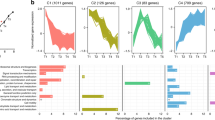Abstract
Analysis of the distribution of 35S-sulfate and 14C-glutamate in major biochemical components of the two marine bacteria, Pseudomonas halodurans and Alteromonas luteo-violaceus, was compared with cell density and total cellular protein during exponential growth in batch culture. For both organisms, the sulfur distribution was restricted principally to the low molecular weight organic and protein fractions, which together accounted for over 90% of the total sulfur. Carbon was more widely distributed, with these two fractions containing only 70% of the total label.
Growth rate constants calculated from increases in cell numbers, protein, and 35S and 14C in the various fractions indicated nearly balanced growth in A. luteo-violaceus, with constants derived from all biosynthetic parameters agreeing within 5% during the exponential phase. In contrast, protein synthesis and 35S incorporation into residue protein constants were 30% higher than constants derived from cell counts and incorporation of 14C in P. halodurans. Therefore the cellular protein content P. halodurans varied over a two-fold range, with maximum protein per cell in the late exponential phase. A distinct reduction in the rate constants for total protein and 35S incorporation into residue protein foreshadowed entry into the stationary phase more than one generation before other parameters.
Incorporation of 35S-sulfate into residue protein paralleled protein synthesis in both bacteria. The weight percent S in protein agreed well with the composition of an “average protein” derived from the literature. Sulfur incorporation into protein may be a useful measurement of marine bacterial protein synthesis.
Similar content being viewed by others
Abbreviations
- L.M.W.:
-
low molecular weight
- TCA:
-
trichloroacetic acid
- CFU:
-
colony forming unit
References
Bradford MM (1976) A rapid and sensitive method for the quantitation of microgram quantitities of protein utilizing the principle of protein-dye binding. Anal Biochem 72:248–254
Carbon JA, Hung L, Jones DS (1965) A reversible oxidative inactivation of specific transfer RNA species. Proc Natl Acad Sci 53:979–986
Cuhel RL, Taylor CD, Jannasch HJ (1981a) Assimilatory sulfur metabolism in marine microorganisms: characteristics and regulation of sulfate transport in Pseudomonas halodurans and Alteromonas luteo-violaceus. J Bacteriol 147:340–349
Cuhel RL, Taylor CD, Jannasch HJ (1981b) Assimilatory sulfur metabolism in marine microorganisms: sulfur metabolism, growth, and protein synthesis of Pseudomonas halodurans and Alteromonas luteo-violaceus during sulfate limitation. Arch Microbiol 130:1–7
Daley RJ, Hobbie JE (1975) Direct counts of aquatic bacteria by a modified epifluorescence technique. Limnol Oceanogr 20:875–882
Henrichs SM (1980) Biogeochemistry of dissolved free amino acids in marine sediments. Doctoral dissertation, Woods Hole Oceanographic Institution, Woods Hole, MA
Holmquist R (1978) Evaluation of compositional nonrandomness in proteins. J Mol Evol 11:349–360
Jukes TH, Holmquist R, Moise H (1975) Amino acid composition of proteins: selection against the genetic code. Science 189:50–51
Lipsett MN (1965) The behavior of 4-thiouridine in the E. coli s-RNA molecule. Biochem Biophys Res Comm 20:224–229
McCready RGL, Laishley EJ, Krouse HR (1975) Stable isotope fractionation by Clostridium pasteurianum. 1. 34S/32S: inverse isotope effects during SO 2-4 and SO 2-3 reduction. Can J Microbiol 21:235–244
Morris I, Glover HE, Yentsch CS (1974) Products of photosynthesis by marine phytoplankton: the effect of environmental factors on the relative rates of protein synthesis. Mar Biol 27:1–9
Reeck GR, Fisher L (1973) A statistical analysis of the amino acid compositions of proteins. Int J Peptide Protein Res 5:109–117
Roberts RB, Abelson PH, Cowie DB, Bolton ET, Britten RJ (1963) Studies of biosynthesis in Escherichia coli. Carnegie Inst Wash Publ No 607:521 pp
Schiff JA, Hodson RC (1970) Pathways of sulfate reduction in algae. Ann NY Acad Sci 175:555–576
Tempest DW, Meers JL, Brown CM (1970) Influence of the environment on the content and composition of microbial free amino acid pools. J Gen Microbiol 64:171–185
Tindall DR, Yopp JH, Schmid WE, Miller DM (1977) Protein and amino acid composition of the obligate halophile, Aphanothece halophytica (Cyanophyta). J Phycol 13:127–133
Author information
Authors and Affiliations
Rights and permissions
About this article
Cite this article
Cuhel, R.L., Taylor, C.D. & Jannasch, H.W. Assimilatory sulfur metabolism in marine microorganisms: Sulfur metabolism, protein synthesis, and growth of Pseudomonas halodurans and Alteromonas luteo-violaceus during unperturbed batch growth. Arch. Microbiol. 130, 8–13 (1981). https://doi.org/10.1007/BF00527064
Received:
Accepted:
Issue Date:
DOI: https://doi.org/10.1007/BF00527064




